sensor TOYOTA BZ4X 2022 (in English) Repair Manual
[x] Cancel search | Manufacturer: TOYOTA, Model Year: 2022, Model line: BZ4X, Model: TOYOTA BZ4X 2022Pages: 674, PDF Size: 120.02 MB
Page 340 of 674
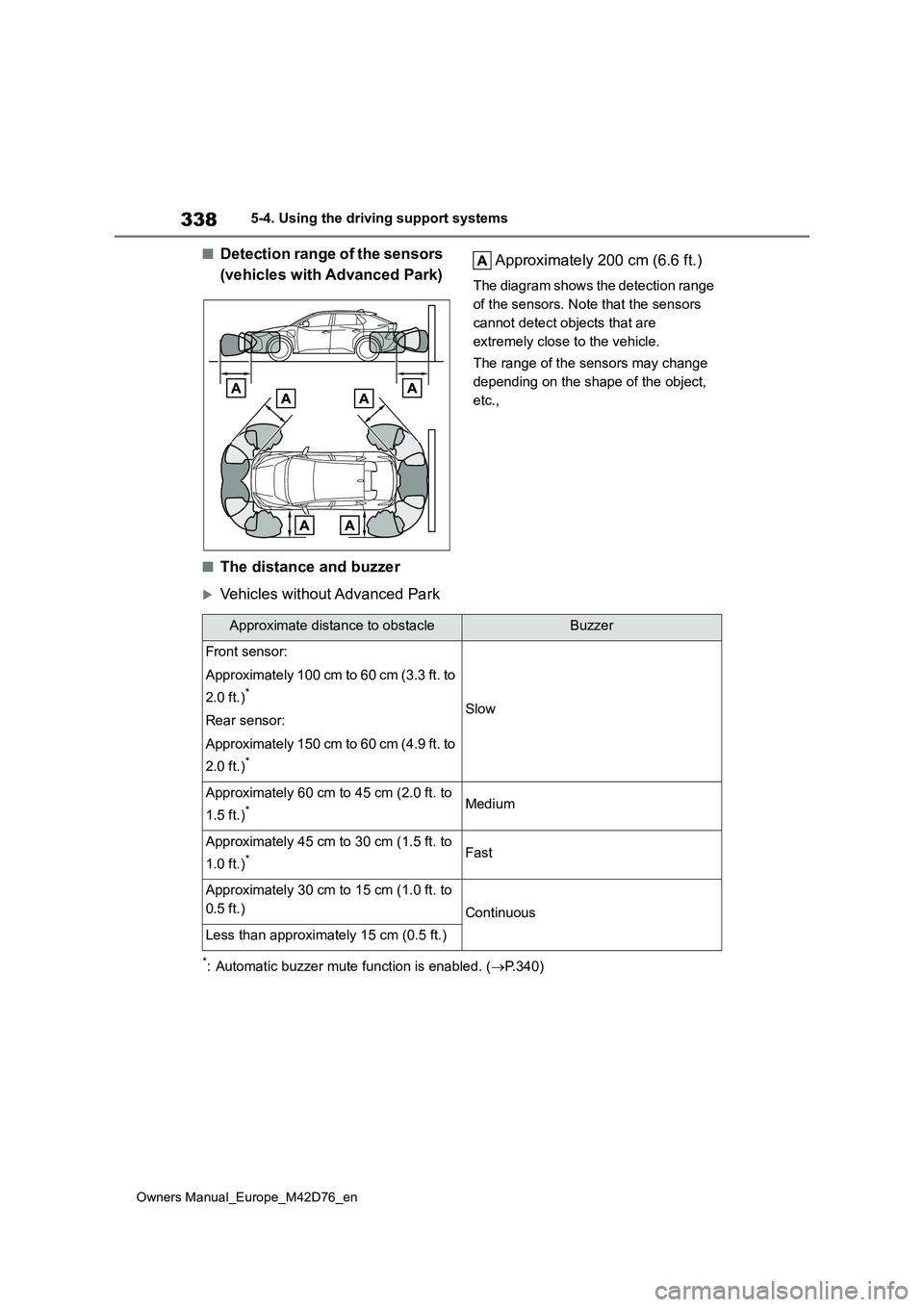
338
Owners Manual_Europe_M42D76_en
5-4. Using the driving support systems
■Detection range of the sensors
(vehicles with Advanced Park) Approximately 200 cm (6.6 ft.)
The diagram shows the detection range
of the sensors. Note that the sensors
cannot detect objects that are
extremely close to the vehicle.
The range of the sensors may change
depending on the shape of the object,
etc.,
■The distance and buzzer
Vehicles without Advanced Park
*: Automatic buzzer mute function is enabled. ( P.340)
Approximate distance to obstacleBuzzer
Front sensor:
Approximately 100 cm to 60 cm (3.3 ft. to
2.0 ft.)*
Rear sensor:
Approximately 150 cm to 60 cm (4.9 ft. to
2.0 ft.)*
Slow
Approximately 60 cm to 45 cm (2.0 ft. to
1.5 ft.)*Medium
Approximately 45 cm to 30 cm (1.5 ft. to
1.0 ft.)*Fast
Approximately 30 cm to 15 cm (1.0 ft. to
0.5 ft.)Continuous
Less than approximately 15 cm (0.5 ft.)
Page 341 of 674
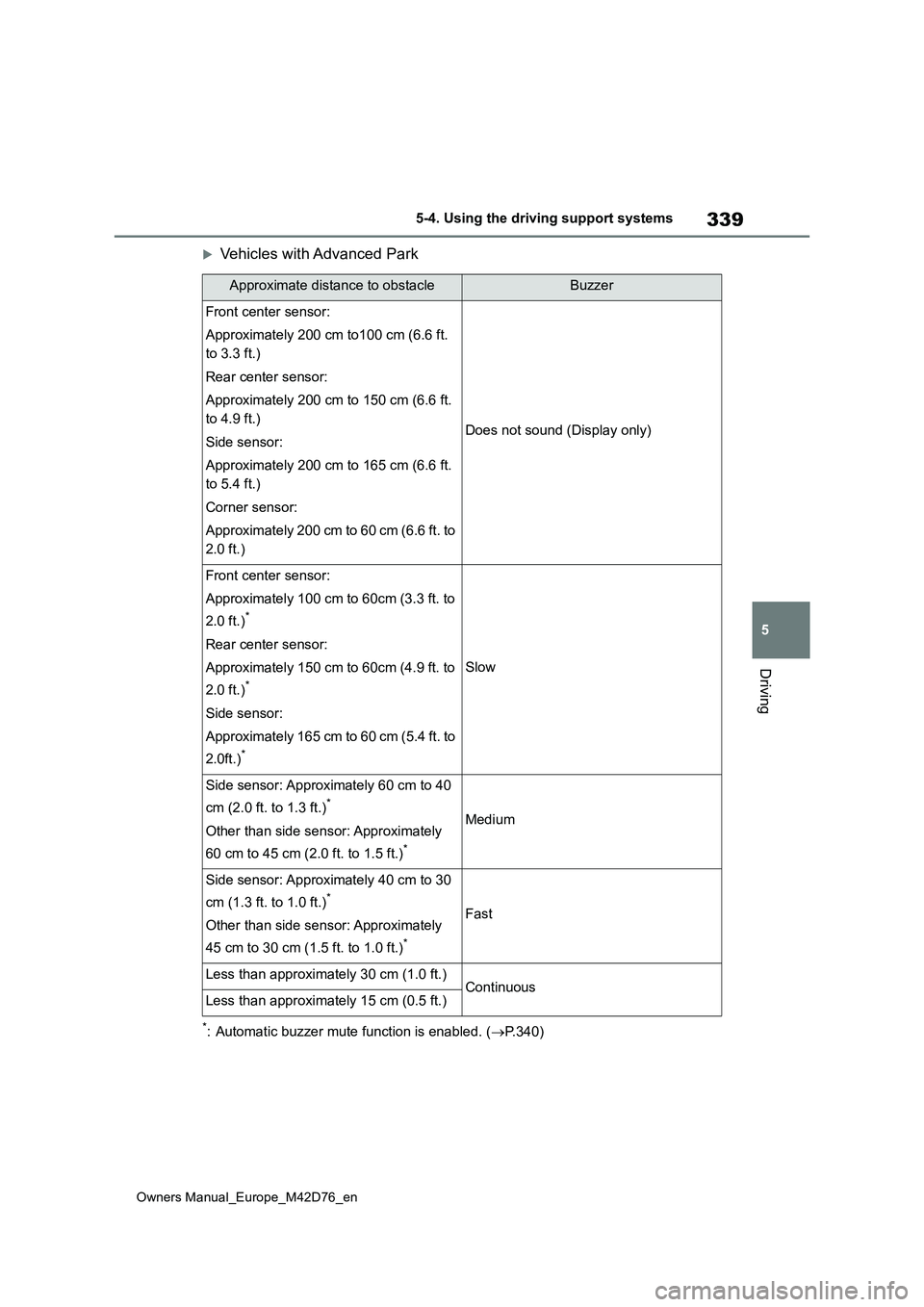
339
5
Owners Manual_Europe_M42D76_en
5-4. Using the driving support systems
Driving
Vehicles with Advanced Park
*: Automatic buzzer mute function is enabled. (P.340)
Approximate distance to obstacleBuzzer
Front center sensor:
Approximately 200 cm to100 cm (6.6 ft.
to 3.3 ft.)
Rear center sensor:
Approximately 200 cm to 150 cm (6.6 ft.
to 4.9 ft.)
Side sensor:
Approximately 200 cm to 165 cm (6.6 ft.
to 5.4 ft.)
Corner sensor:
Approximately 200 cm to 60 cm (6.6 ft. to
2.0 ft.)
Does not sound (Display only)
Front center sensor:
Approximately 100 cm to 60cm (3.3 ft. to
2.0 ft.)*
Rear center sensor:
Approximately 150 cm to 60cm (4.9 ft. to
2.0 ft.)*
Side sensor:
Approximately 165 cm to 60 cm (5.4 ft. to
2.0ft.)*
Slow
Side sensor: Approximately 60 cm to 40
cm (2.0 ft. to 1.3 ft.)*
Other than side sensor: Approximately
60 cm to 45 cm (2.0 ft. to 1.5 ft.)*
Medium
Side sensor: Approximately 40 cm to 30
cm (1.3 ft. to 1.0 ft.)*
Other than side sensor: Approximately
45 cm to 30 cm (1.5 ft. to 1.0 ft.)*
Fast
Less than approximately 30 cm (1.0 ft.)ContinuousLess than approximately 15 cm (0.5 ft.)
Page 342 of 674
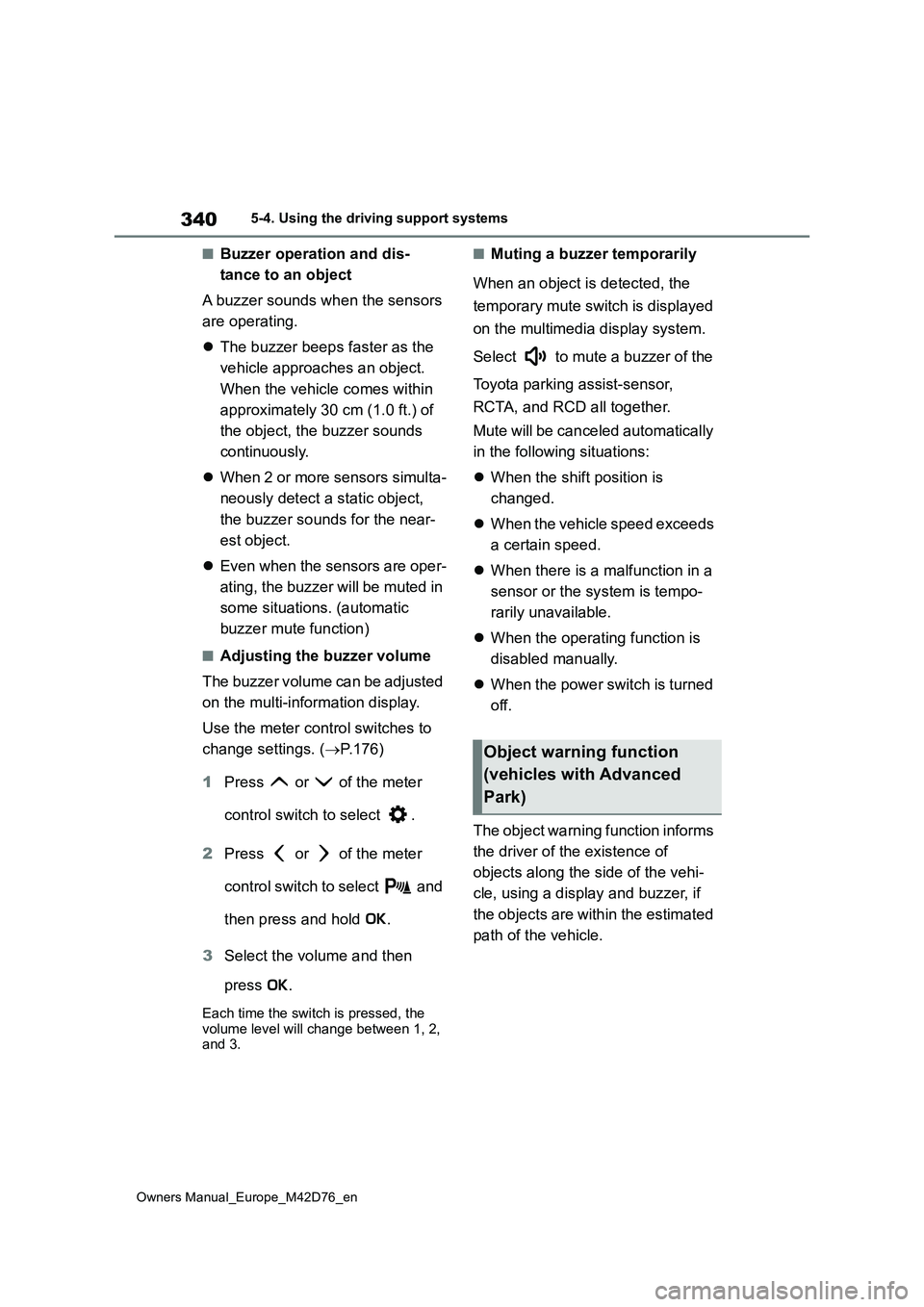
340
Owners Manual_Europe_M42D76_en
5-4. Using the driving support systems
■Buzzer operation and dis-
tance to an object
A buzzer sounds when the sensors
are operating.
The buzzer beeps faster as the
vehicle approaches an object.
When the vehicle comes within
approximately 30 cm (1.0 ft.) of
the object, the buzzer sounds
continuously.
When 2 or more sensors simulta-
neously detect a static object,
the buzzer sounds for the near-
est object.
Even when the sensors are oper-
ating, the buzzer will be muted in
some situations. (automatic
buzzer mute function)
■Adjusting the buzzer volume
The buzzer volume can be adjusted
on the multi-information display.
Use the meter control switches to
change settings. ( P.176)
1 Press or of the meter
control switch to select .
2 Press or of the meter
control switch to select and
then press and hold .
3 Select the volume and then
press .
Each time the switch is pressed, the volume level will change between 1, 2, and 3.
■Muting a buzzer temporarily
When an object is detected, the
temporary mute switch is displayed
on the multimedia display system.
Select to mute a buzzer of the
Toyota parking assist-sensor,
RCTA, and RCD all together.
Mute will be canceled automatically
in the following situations:
When the shift position is
changed.
When the vehicle speed exceeds
a certain speed.
When there is a malfunction in a
sensor or the system is tempo-
rarily unavailable.
When the operating function is
disabled manually.
When the power switch is turned
off.
The object warning function informs
the driver of the existence of
objects along the side of the vehi-
cle, using a display and buzzer, if
the objects are within the estimated
path of the vehicle.
Object warning function
(vehicles with Advanced
Park)
Page 343 of 674
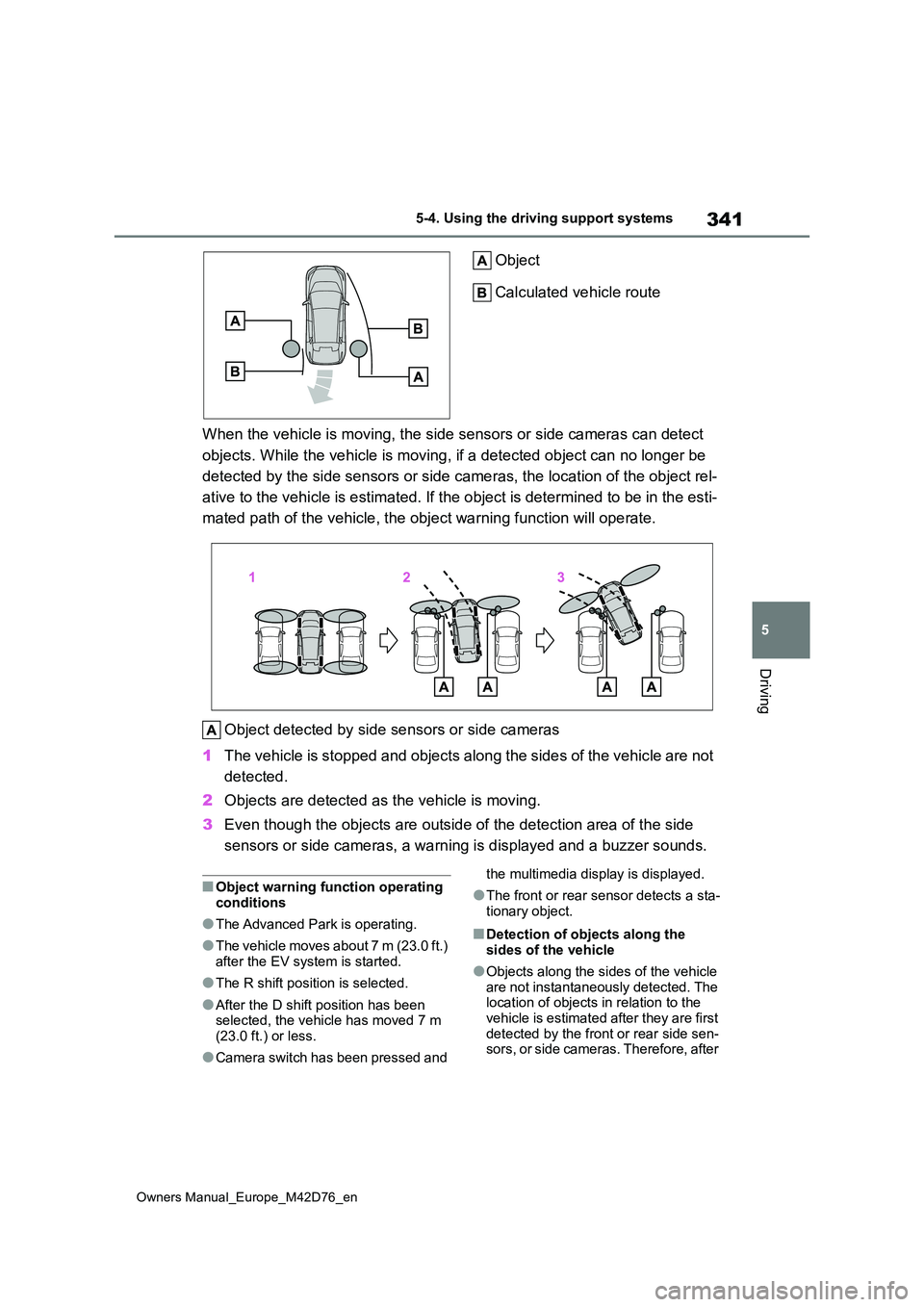
341
5
Owners Manual_Europe_M42D76_en
5-4. Using the driving support systems
Driving
Object
Calculated vehicle route
When the vehicle is moving, the side sensors or side cameras ca n detect
objects. While the vehicle is moving, if a detected object can no longer be
detected by the side sensors or side cameras, the location of t he object rel-
ative to the vehicle is estimated. If the object is determined to be in the esti-
mated path of the vehicle, the object warning function will ope rate.
Object detected by side sensors or side cameras
1 The vehicle is stopped and objects along the sides of the vehicle are not
detected.
2 Objects are detected as the vehicle is moving.
3 Even though the objects are outside of the detection area of the side
sensors or side cameras, a warning is displayed and a buzzer so unds.
■Object warning function operating conditions
●The Advanced Park is operating.
●The vehicle moves about 7 m (23.0 ft.)
after the EV system is started.
●The R shift position is selected.
●After the D shift position has been selected, the vehicle has moved 7 m
(23.0 ft.) or less.
●Camera switch has been pressed and
the multimedia display is displayed.
●The front or rear sensor detects a sta-
tionary object.
■Detection of objects along the sides of the vehicle
●Objects along the sides of the vehicle are not instantaneously detected. The location of objects in relation to the
vehicle is estimated after they are first detected by the front or rear side sen-sors, or side cameras. Therefore, after
Page 344 of 674
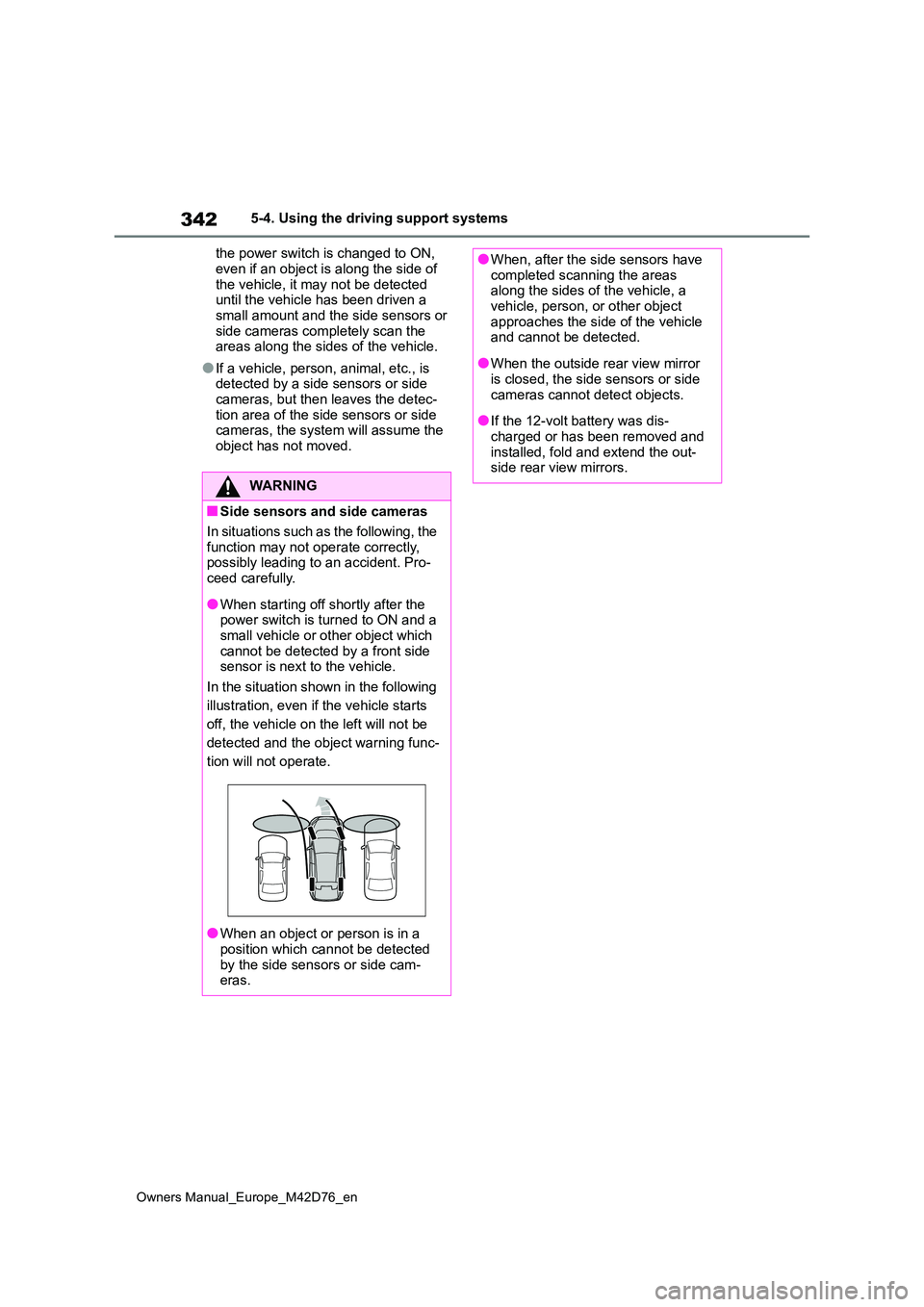
342
Owners Manual_Europe_M42D76_en
5-4. Using the driving support systems
the power switch is changed to ON,
even if an object is along the side of the vehicle, it may not be detected until the vehicle has been driven a
small amount and the side sensors or side cameras completely scan the areas along the sides of the vehicle.
●If a vehicle, person, animal, etc., is detected by a side sensors or side
cameras, but then leaves the detec- tion area of the side sensors or side cameras, the system will assume the
object has not moved.
WARNING
■Side sensors and side cameras
In situations such as the following, the
function may not operate correctly, possibly leading to an accident. Pro-ceed carefully.
●When starting off shortly after the power switch is turned to ON and a
small vehicle or other object which cannot be detected by a front side sensor is next to the vehicle.
In the situation shown in the following
illustration, even if the vehicle starts
off, the vehicle on the left will not be
detected and the object warning func-
tion will not operate.
●When an object or person is in a position which cannot be detected
by the side sensors or side cam- eras.
●When, after the side sensors have completed scanning the areas along the sides of the vehicle, a
vehicle, person, or other object approaches the side of the vehicle and cannot be detected.
●When the outside rear view mirror is closed, the side sensors or side
cameras cannot detect objects.
●If the 12-volt battery was dis-
charged or has been removed and installed, fold and extend the out-side rear view mirrors.
Page 345 of 674
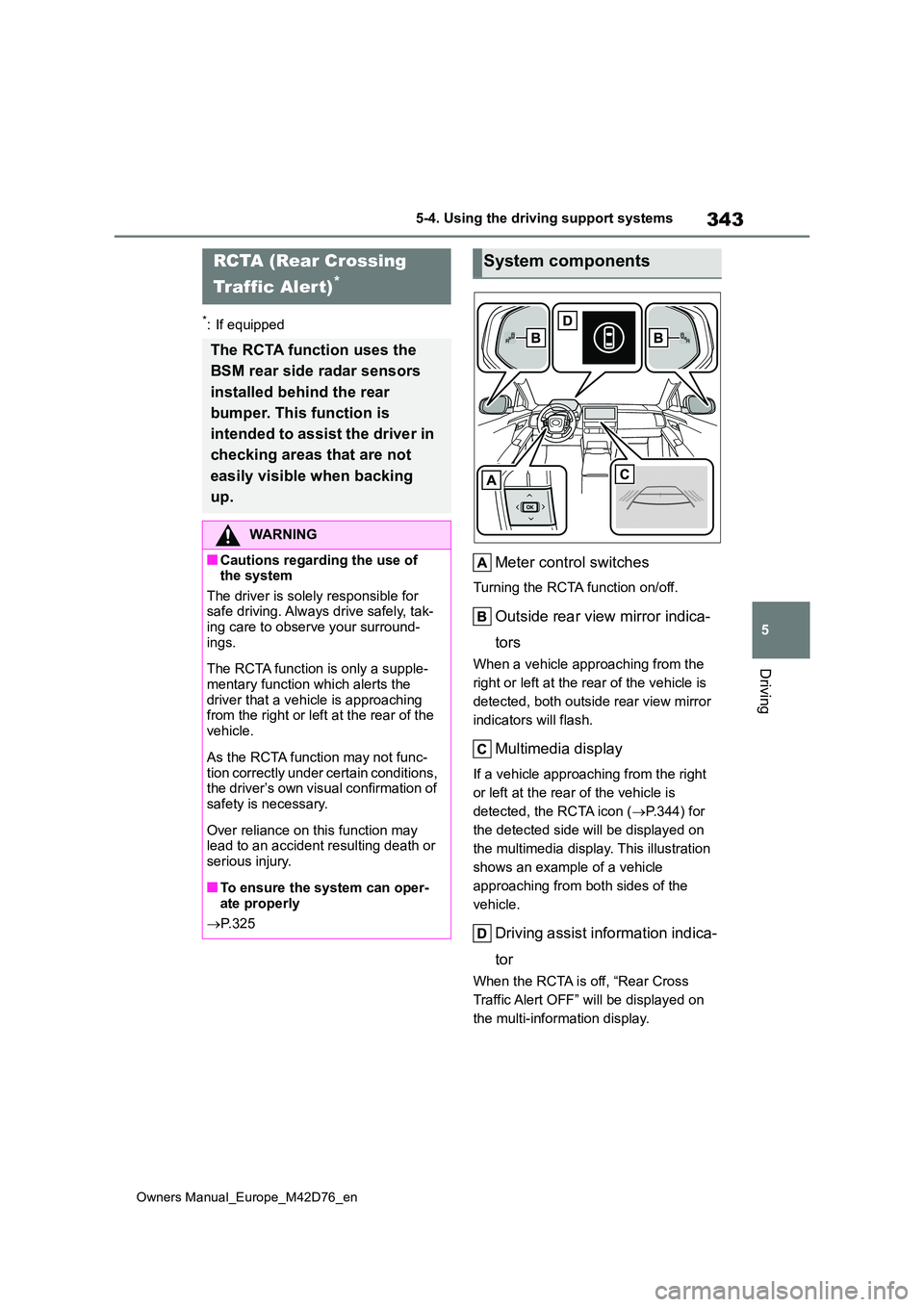
343
5
Owners Manual_Europe_M42D76_en
5-4. Using the driving support systems
Driving
*: If equipped
Meter control switches
Turning the RCTA function on/off.
Outside rear view mirror indica-
tors
When a vehicle approaching from the
right or left at the rear of the vehicle is
detected, both outside rear view mirror
indicators will flash.
Multimedia display
If a vehicle approaching from the right
or left at the rear of the vehicle is
detected, the RCTA icon ( P.344) for
the detected side will be displayed on
the multimedia display. This illustration
shows an example of a vehicle
approaching from both sides of the
vehicle.
Driving assist information indica-
tor
When the RCTA is off, “Rear Cross
Traffic Alert OFF” will be displayed on
the multi-information display.
RCTA (Rear Crossing
Traffic Alert)*
The RCTA function uses the
BSM rear side radar sensors
installed behind the rear
bumper. This function is
intended to assist the driver in
checking areas that are not
easily visible when backing
up.
WARNING
■Cautions regarding the use of the system
The driver is solely responsible for safe driving. Always drive safely, tak-ing care to observe your surround-
ings.
The RCTA function is only a supple-
mentary function which alerts the driver that a vehicle is approaching from the right or left at the rear of the
vehicle.
As the RCTA function may not func-
tion correctly under certain conditions, the driver’s own visual confirmation of safety is necessary.
Over reliance on this function may lead to an accident resulting death or
serious injury.
■To ensure the system can oper-
ate properly
P. 3 2 5
System components
Page 346 of 674
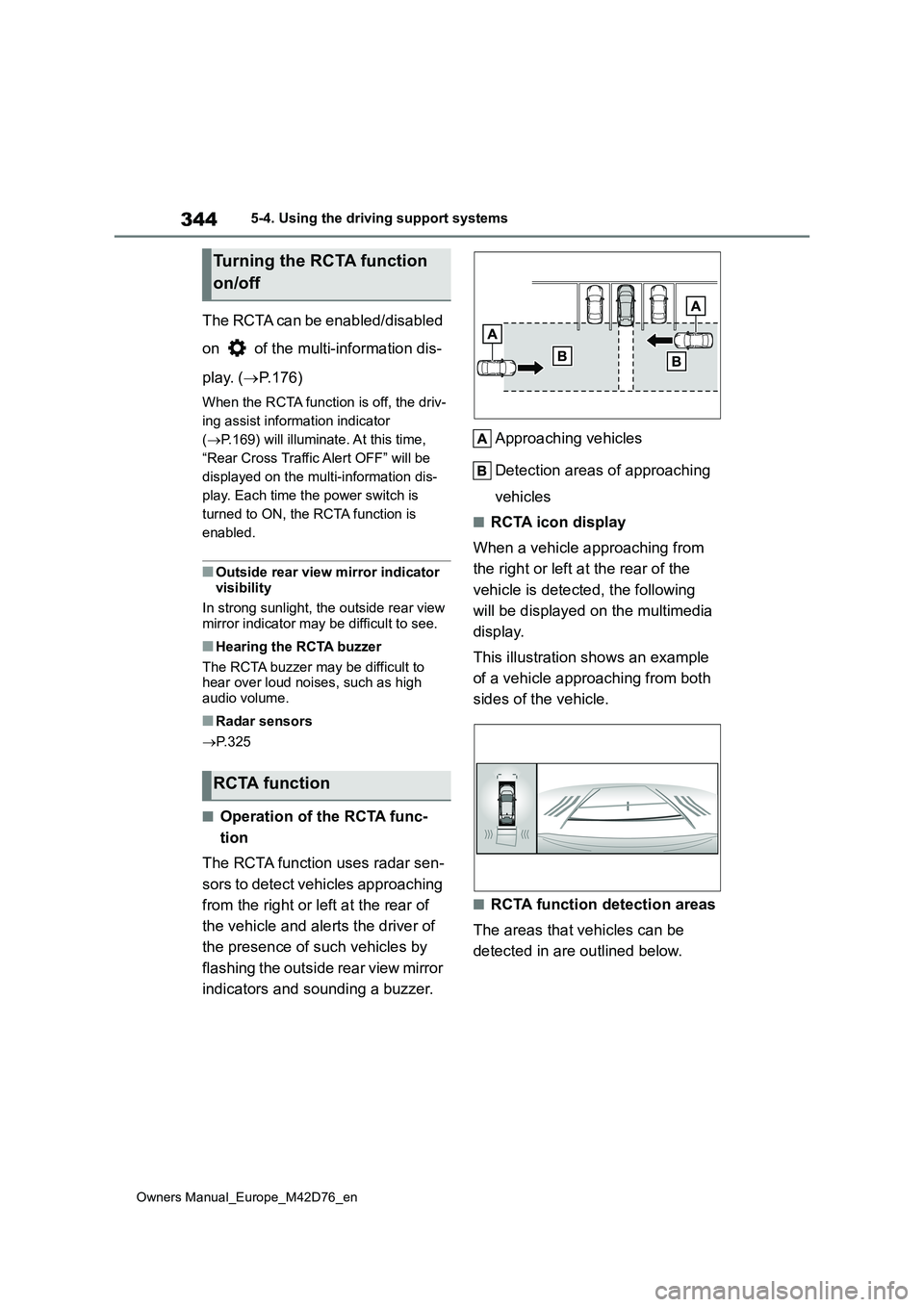
344
Owners Manual_Europe_M42D76_en
5-4. Using the driving support systems
The RCTA can be enabled/disabled
on of the multi-information dis-
play. ( P.176)
When the RCTA function is off, the driv-
ing assist information indicator
( P.169) will illuminate. At this time,
“Rear Cross Traffic Alert OFF” will be
displayed on the multi-information dis-
play. Each time the power switch is
turned to ON, the RCTA function is
enabled.
■Outside rear view mirror indicator
visibility
In strong sunlight, the outside rear view mirror indicator may be difficult to see.
■Hearing the RCTA buzzer
The RCTA buzzer may be difficult to hear over loud noises, such as high audio volume.
■Radar sensors
P. 3 2 5
■Operation of the RCTA func-
tion
The RCTA function uses radar sen-
sors to detect vehicles approaching
from the right or left at the rear of
the vehicle and alerts the driver of
the presence of such vehicles by
flashing the outside rear view mirror
indicators and sounding a buzzer.
Approaching vehicles
Detection areas of approaching
vehicles
■RCTA icon display
When a vehicle approaching from
the right or left at the rear of the
vehicle is detected, the following
will be displayed on the multimedia
display.
This illustration shows an example
of a vehicle approaching from both
sides of the vehicle.
■RCTA function detection areas
The areas that vehicles can be
detected in are outlined below.
Turning the RCTA function
on/off
RCTA function
Page 347 of 674
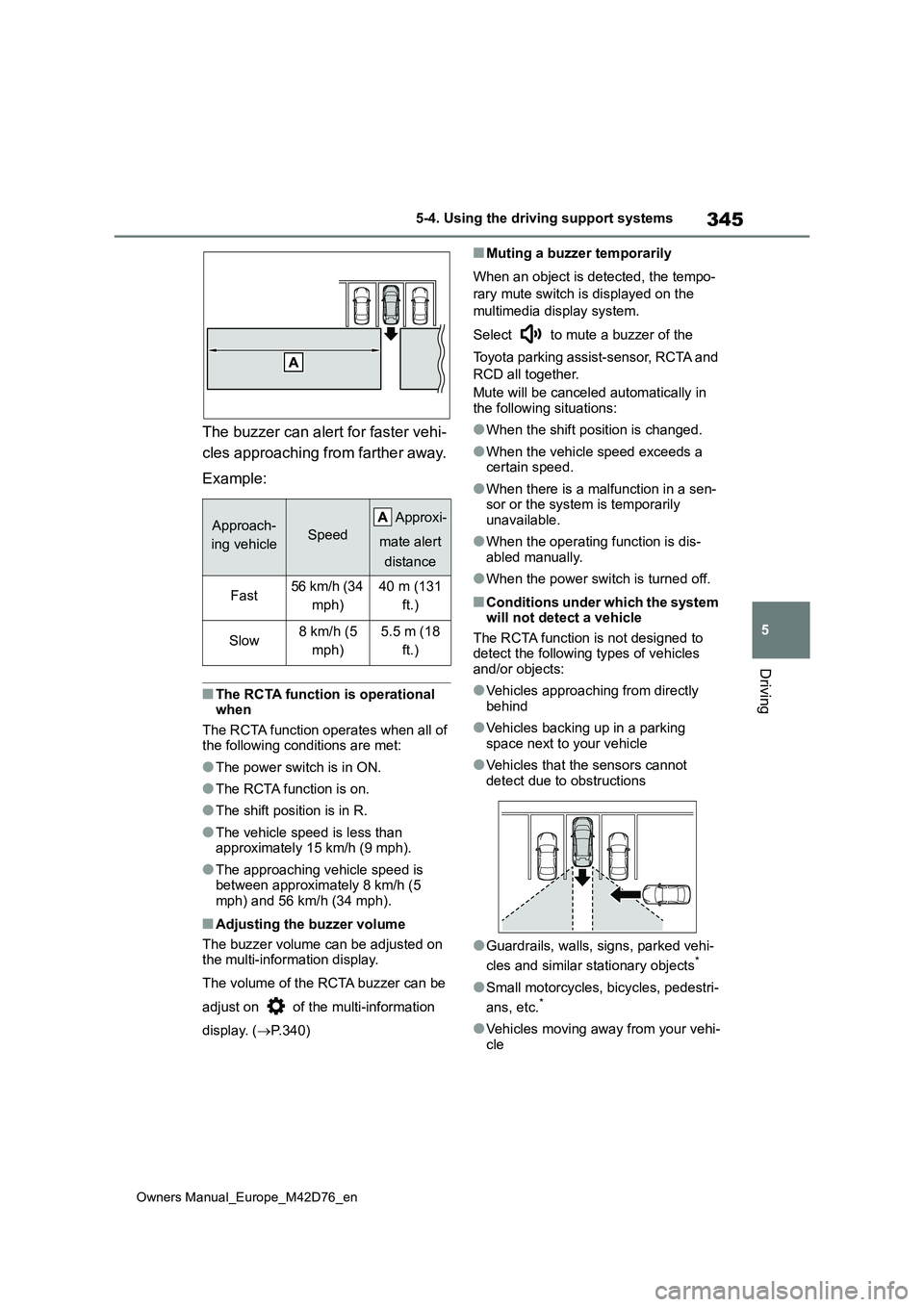
345
5
Owners Manual_Europe_M42D76_en
5-4. Using the driving support systems
Driving
The buzzer can alert for faster vehi-
cles approaching from farther away.
Example:
■The RCTA function is operational when
The RCTA function operates when all of the following conditions are met:
●The power switch is in ON.
●The RCTA function is on.
●The shift position is in R.
●The vehicle speed is less than approximately 15 km/h (9 mph).
●The approaching vehicle speed is between approximately 8 km/h (5 mph) and 56 km/h (34 mph).
■Adjusting the buzzer volume
The buzzer volume can be adjusted on the multi-information display.
The volume of the RCTA buzzer can be
adjust on of the multi-information
display. ( P.340)
■Muting a buzzer temporarily
When an object is detected, the tempo-
rary mute switch is displayed on the
multimedia display system.
Select to mute a buzzer of the
Toyota parking assist-sensor, RCTA and
RCD all together.
Mute will be canceled automatically in the following situations:
●When the shift position is changed.
●When the vehicle speed exceeds a certain speed.
●When there is a malfunction in a sen-sor or the system is temporarily unavailable.
●When the operating function is dis-abled manually.
●When the power switch is turned off.
■Conditions under which the system will not detect a vehicle
The RCTA function is not designed to detect the following types of vehicles and/or objects:
●Vehicles approaching from directly behind
●Vehicles backing up in a parking space next to your vehicle
●Vehicles that the sensors cannot detect due to obstructions
●Guardrails, walls, signs, parked vehi-
cles and similar stationary objects*
●Small motorcycles, bicycles, pedestri-
ans, etc.*
●Vehicles moving away from your vehi- cle
Approach-
ing vehicleSpeed
A pp r ox i -
mate alert
distance
Fast56 km/h (34
mph)
40 m (131
ft.)
Slow8 km/h (5
mph)
5.5 m (18
ft.)
Page 348 of 674
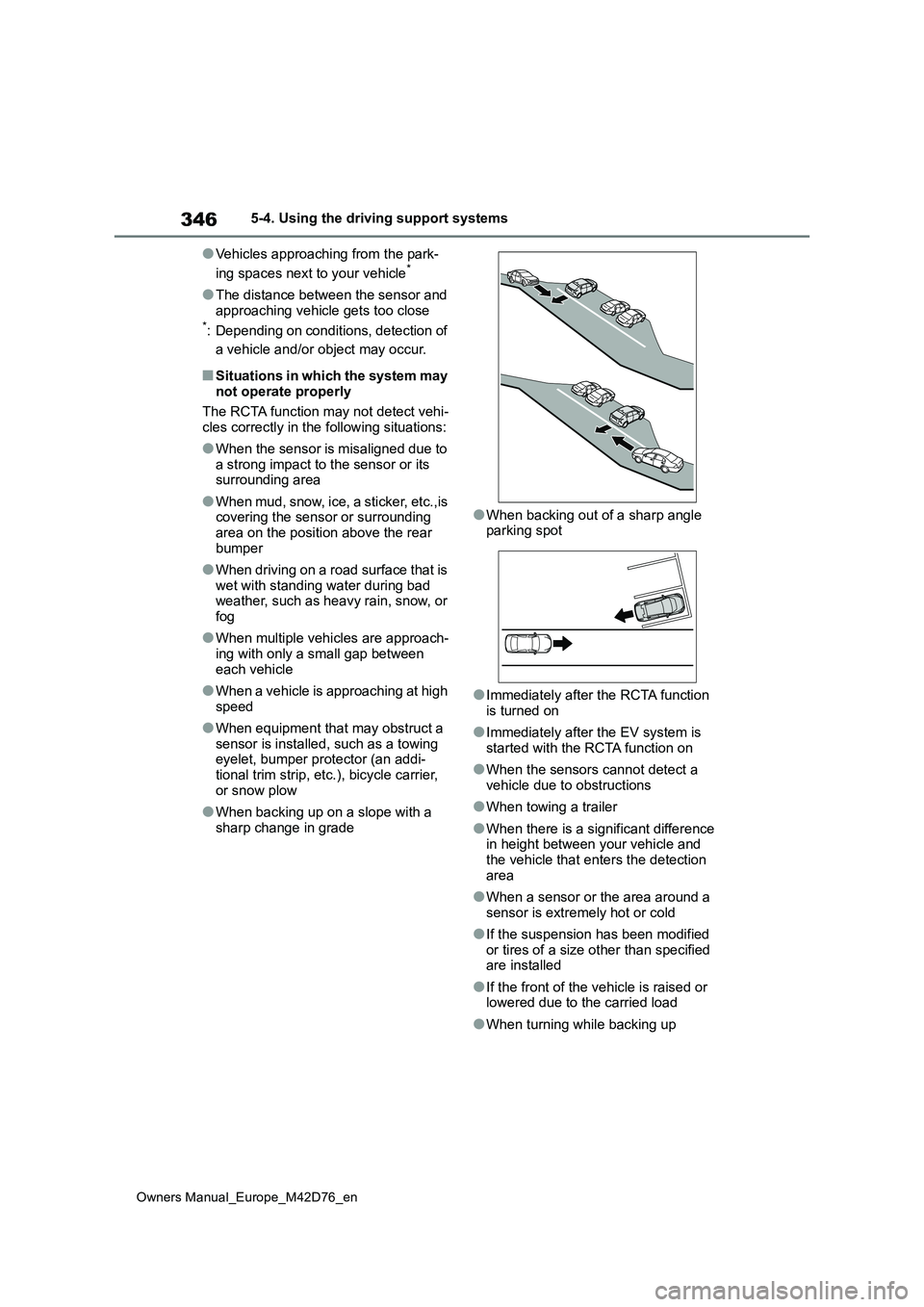
346
Owners Manual_Europe_M42D76_en
5-4. Using the driving support systems
●Vehicles approaching from the park-
ing spaces next to your vehicle*
●The distance between the sensor and
approaching vehicle gets too close*: Depending on conditions, detection of
a vehicle and/or object may occur.
■Situations in which the system may not operate properly
The RCTA function may not detect vehi-
cles correctly in the following situations:
●When the sensor is misaligned due to
a strong impact to the sensor or its surrounding area
●When mud, snow, ice, a sticker, etc.,is covering the sensor or surrounding area on the position above the rear
bumper
●When driving on a road surface that is
wet with standing water during bad weather, such as heavy rain, snow, or fog
●When multiple vehicles are approach-ing with only a small gap between
each vehicle
●When a vehicle is approaching at high
speed
●When equipment that may obstruct a
sensor is installed, such as a towing eyelet, bumper protector (an addi-tional trim strip, etc.), bicycle carrier,
or snow plow
●When backing up on a slope with a
sharp change in grade
●When backing out of a sharp angle parking spot
●Immediately after the RCTA function is turned on
●Immediately after the EV system is started with the RCTA function on
●When the sensors cannot detect a vehicle due to obstructions
●When towing a trailer
●When there is a significant difference in height between your vehicle and the vehicle that enters the detection
area
●When a sensor or the area around a
sensor is extremely hot or cold
●If the suspension has been modified
or tires of a size other than specified are installed
●If the front of the vehicle is raised or lowered due to the carried load
●When turning while backing up
Page 349 of 674

347
5
Owners Manual_Europe_M42D76_en
5-4. Using the driving support systems
Driving
●When a vehicle turns into the detec-
tion area
■Situations in which the system may
operate even if there is no possibil- ity of a collision
Instances of the RCTA function unnec-
essary detecting a vehicle and/or object may increase in the following situations:
●When the parking space faces a street and vehicles are being driven on the street
●When the distance between your vehi-cle and metal objects, such as a
guardrail, wall, sign, or parked vehicle, which may reflect electrical waves toward the rear of the vehicle, is short
●When equipment that may obstruct a
sensor is installed, such as a towing eyelet, bumper protector (an addi-tional trim strip, etc.), bicycle carrier,
or snow plow
●When a vehicle passes by the side of
your vehicle
●When a detected vehicle turns while
approaching the vehicle
●When there are spinning objects near
your vehicle such as the fan of an air conditioning unit
●When water is splashed or sprayed toward the rear bumper, such as from a sprinkler
●Moving objects (flags, exhaust fumes, large rain droplets or snowflakes, rain
water on the road surface, etc.)
●When the distance between your vehi-
cle and a guardrail, wall, etc., that enters the detection area is short
●Gratings and gutters